15. Controlled Upset, Then and Now
Asophisticate among early hollow point bullets was Peters’ Protected Point. Its jacket enveloped a flat-topped core, the front third wrapped in a gilding metal band and crowned with a pointed metal cone. On impact the flattening nose drove the band down under the jacket, where it initiated and controlled the core’s upset. The jacket split as expansion progressed. A Protected Point bullet required 51 operations and three hours to manufacture. Winchester’s Silvertip, overhauled in 1960 and now discontinued, was a less costly rendition of this design. It lacked an inner band.
Remington put a hard peg in a hollow bullet nose to form its Bronze Point. Upon striking a target, this peg was driven back into the bullet to start expansion. Bronze Point bullets opened pretty violently at close range. RWS has counterparts to this design: the TIG (Torpedo Ideal) and TUG (Torpedo Universal) bullets. The TIG’s tail section has a funnel-shaped mouth into which the nose core fits like a plug. Upset starts not only at the nose but at the core juncture. The rear core opens more reluctantly because it’s harder.. In TUG bullets the joint is reversed: A cavity in the nose accepts a conical protrusion from the rear section, which acts like a trailing bullet when the nose fragments. The pointed tail resists deformation, penetrating like the trunk of a Nosler Partition.
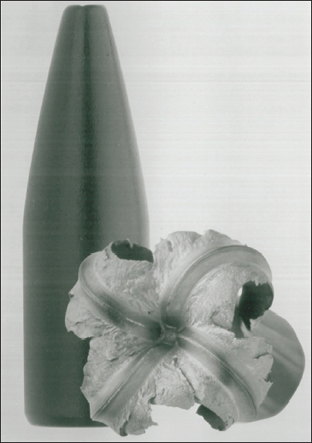
Lead-free bullets, such as this Barnes X, can be designed to mushroom with deadly effect. Deep penetration and high weight retention are the hallmarks of the hollowpoint X and TSX, both engineered for big game hunting.
Bitterroot Bullet Company also used unalloyed copper for its jackets, which in .338 could be .060 inch thick. The nose of a Bitterroot bullet had a cavity to start expansion. These features made Bitterroots long for their weight, and the most renowned were heavy for their caliber. They required deep seating and an eye to pressures hiked by extended bearing surfaces.
Among the best known of bullet-makers specializing in tough bullets is Barnes. This firm started operations in 1939, predating John Nosler’s by nine years. Barnes “Original” bullets, from .22 to .600, were available in a wide range of weights, many heavy for the caliber. The line has diminished of late, because Randy and Coni Brooks, who’ve owned Barnes for more than 35 years, designed and promote the sleeker, all-copper X and Triple Shock bullets. The Originals remain available for big-bore and obsolete cartridges like the .50-110 and .348 Winchester. Their jackets are of pure copper, .032 and .049 inch thick, depending on the application. The jackets have no taper, and the thick ones depend on a substantial jolt to open. One new bullet of similar design is the Barnes Buster, with a thick copper jacket and hard-cast lead core.
The dilemma confronting big game hunters these days is whether to choose the flattest-shooting bullet, the most accurate bullet or the bullet that penetrates best and retains the most weight after upset. It is unlikely one bullet will score at the top in all three categories. Despite what some shooters say, the sleek hollow point bullets that deliver flat flight and fine accuracy can also kill effectively at long range. I’ve even taken elk with lightweight bullets of this design. Distance is their friend, as it drains some of the velocity that can smash such bullets to pieces when they strike big muscles or bones at high speed close to the rifle. For heavy game at modest ranges, stout controlled-expansion bullets certainly make sense, because reliable upset and penetration matters more than one-hole precision.

Wayne shot this eland in Namibia with a Montana rifle in .375 H&H, Federal 300-grain TSX.
Here’s a brief review of the best-known big game bullets:
Barnes X. This solid copper hollowpoint is sleek in form but lightweight for its length. So heavy X-Bullets must be seated deep to clear some magazine boxes and rifling (heed factory cautions here). On the other hand, the X is built to drive deep without losing significant weight. So you can use a lighter bullet and get fast flight, a taut trajectory and deep penetration at the same time. X-Bullets don’t offer the frontal area of many lead-core bullets after expansion, and pass-throughs are common. Reports on accuracy vary from very good to sub-par.
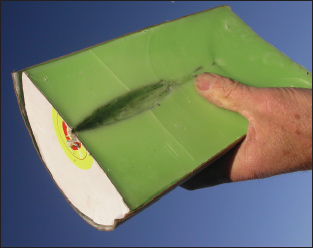
Richard Mann and Charlie Sisk designed the “Test Tube” to assess bullet upset, wound channels.

Polymer-tipped lead bullets have earned a reputation for ballistic efficiency and accuracy. Note the air pocket; it gives the tip a running start to initiate expansion.
Barnes Triple Shock. X-Bullets have now been replaced in the Barnes catalog by Triple Shock or TSX bullets, with shank grooves that reduce pressure while enhancing accuracy. The nose design is similar, and TSX bullets are of the same all-copper construction. New TSX Tipped bullets wear a polymer tip, more for cosmetic appeal than to boost ballistic coefficient. The MRX bullet has the TSX profile, but a denser-than-lead Silvex heel core. The shank can thus be shorter, an advantage when magazine length or throating limits over-all cartridge length.
Nosler Partition. Developed in 1947 by John Nosler to penetrate better than bullets he could buy, the Partition was initially distributed only to his hunting buddies. The wall of jacket material between front and rear core sections stops expansion and ensures the shank will penetrate. Nosler Partitions commonly lose significant weight from the nose during penetration. But those fragments destroy a lot of tissue while the shank plows dependably forward. Hunters who have relied on Partitions know retained weight is hardly a measure of lethality! Partition jackets were once machined from solid stock; now they’re impact-extruded, resulting in closer tolerances, better accuracy.
Remington Core-Lokt Ultra Bonded. Based on the tried-and-true Core-Lokt, the C-L Ultra has a jacket that is 20–50 percent heavier at mid-section, where the jacket is thickest, to arrest any tendency of the core to shift during penetration. As the name states, the core and jacket are bonded, further enhancing weight retention. Remington advertises the double-diameter upset typically seen with standard Core-Lokts. The Core-Lokt Ultra Bonded is available in many Remington Premier factory loads.
Speer Grand Slam. This dual-core bullet has a hard lead heel (5 percent antimony) held in place by an internal jacket lip. The nose core is softer, for quick upset and a broad mushroom. Grand Slam gilding metal jackets are 4 percent thicker than those on Speer Hot-Cor bullets. During manufacture, both types receive their cores in molten form, to eliminate voids that cause jacket-core separation. The Grand Slam has an aerodynamic ogive behind a protected (flat) nose.
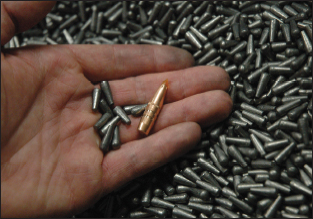
In Federal’s ammunition plant, jackets are bonded to these cores to make Trophy Bonded bullets.
Swift A-Frame. This bullet, developed by Lee Reed of Quinter, Kansas, features a bonded core plus a midsection wall of jacket material. The result: very deep penetration with an intact but beautifully expanded nose. The A-Frame mushroom looks like a mushroom, and plows a broad wound channel. The A-Frame typically retains more than 90 percent of its weight, even in the toughest game. It ranks among the most dependable bullets for heavy animals, in rifles and in handguns.
Swift Scirocco. First available in 1999, the Scirocco combines the sleek form and polymer tip of Nosler’s Ballistic Tip bullet with the ductile copper jacket and bonded core of the Swift A-Frame. It flies flatter than the A-Frame but still delivers controlled upset at high impact speeds. Weight retention averages a bit less than the A-Frame, but shooters can expect over 70 percent even at strike velocities of over 3,000 fps. The Scirocco opens at terminal speeds as low as 1,440 fps.
Trophy Bonded Bear Claw. Jack Carter designed this lead-core bullet for high weight retention in heavy muscle and bone. The thick, ductile copper jacket incorporates a heel section that extends to near the mid-point of the bullet. Mushrooming yields a broad nose that rarely loses more than 10 percent of its weight in the toughest going. Like the Swift A-Frame and Speer Grand Slam, the Trophy Bonded Bear Claw has a sleek ogive and a flat nose. Federal Cartridge Company acquired manufacturing rights from Jack Carter before his death and now manufactures the Trophy Bonded Bear Claw. A Trophy Bonded Tip bullet with a conical polymer nose insert has been added to the line. Both TB bullets are loaded by Federal.
Winchester Power Max Bonded. Otherwise of ordinary lead-core construction, the Super-X Power Max Bonded bullet features a core-jacket bond to improve weight retention. It takes the place of the Silver Tip in Winchester’s Super-X line of loaded ammunition, complementing the Power-Point softpoint.
Winchester AccuBond. Developed with Nosler, Winchester’s AccuBond has a sleek profile, with a polymer tip that caps a lead core bonded to a gilding metal jacket with reinforced shank and thick heel. It is loaded in Winchester’s Supreme line of ammunition.
Winchester XP3. In some ways, the XP3 bullet resembles the discontinued Winchester Fail Safe. Its nose, of solid alloy, is an extension of the jacket, with a deep cavity under a polymer tip. The lead core fills the shank to mid-section and is bonded to the jacket.

A Swift bullet in a Norma load nips tight groups from Wayne’s CZ 550 in 9.3x62. It’s lethal too!
Off-shore bullet companies offer competitive products. Australia’s Woodleigh bullets, now loaded by Federal, have a fine reputation; core and jacket are as hard to separate as a pit bull and a burglar. Expansion tests in water (a severe medium) yield terminal weights that exceed 90 percent of initial weights. Petals open out wing-like, rather than collapsing to support a classic mushroom, as with Swift and Trophy Bonded bullets. But despite their action in braking the bullet and their exposure to rotational pressures, petals on Woodleighs seldom break or lose lead on their forward surfaces.
I have had excellent success with Norma’s Oryx, increasingly popular among European hunters. It has a core-jacket bond that ensures deep penetration and high weight retention. Norma’s Plastic Point, Soft Point, and Alaska bullets are designed to upset more easily and violently. So is the company’s Vulkan, a hollowpoint with the jacket folded at the nose to minimize damage in the magazine.
Keen hunter interest in deep-driving bullets continues to drive a cottage industry. Blue Mountain Bullets and Elkhorn Bullets, both Oregon companies, have specialized in bullets for elk. Warren Jensen of Blackfoot, Idaho, improved on his sleek J-26 spitzer by replacing the polycarbonate tip with one of soft copper and making other, less visible changes. Mike Brady, of Glenrock, Wyoming, designed a controlled-expansion bullet with a ribbed heel to reduce bore friction. Northern Precision, initially focused on big-bore bullets, added smaller diameters and special-order weights. Hawk bullets, designed in Wyoming by Bob Fulton, have a rounded form but fly surprisingly flat (the bullet’s ogive has a greater effect on trajectory than does tip profile). Like Kodiak bullets made in Alaska for tough game, they wear thick copper jackets.
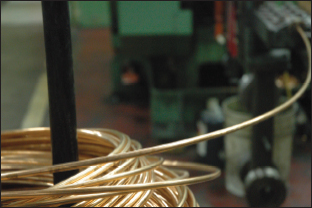
Bullet jackets come from great rolls of copper wire at Federal’s Anoka, Minnesota plant.

These Trophy Bonded bullets recovered from Australian buffalo show double-diameter upset, high weight retention.
If you hunt where oblique shots at elk or moose or big bear are common, you’ll want a cohesive bullet that plows a long furrow. But most big game is taken with bullets through the ribs. Even animals that weigh more than half a ton usually succumb quickly to an ordinary softpoint driven through the front ribs. Here are some bullets that cost less (and may shoot more accurately) than bullets built to retain weight. On deer-size game, they can also kill quicker, because explosive energy release in the vitals kills right away.
Federal Hi-Shok Softpoint. The standard bullet for Federal’s Classic line, Hi-Shok is available in round-nose, flat-nose, and spitzer form, in diameters .224 to .375. Like ordinary softpoint bullets loaded in PMC cartridges, the Hi-Shok is unremarkable in design. However, it is remarkably effective, a bargain in loaded ammunition.
Hornady Interlock. The reputation for fine accuracy that attended the company’s flagship Spire Point for decades carried over to the Interlock. Inner jacket belting holds the lead core in place during upset. Roundnose versions are dependable killers and as accurate as their pointed brethren. Also, they pack more weight for any given length.
Hornady Super Shock Tip (SST). This bullet features the internal jacket belt of Hornady Interlock bullets. A sleek ogive that ends in a red polymer tip gives the SST an edge at extreme range. So does the tapered heel. Initial tests showed the SST a bit fragile for tough game, so it was beefed up to better withstand high-speed impact. An accurate bullet, the SST routinely turns in half-minute groups at Hornady’s range.
Nosler Ballistic Tip. The polycarbonate tip of this Nosler is color-coded by caliber and serves as a wedge to initiate expansion upon impact. Ballistic Tip bullets have an enviable reputation for accuracy and their sleek profile ensures flat flight. They’re noted for quick upset and are not recommended for big-boned game. However, .338 Ballistic Tips have thick jackets for deeper penetration than expected from sub-.33s.
Remington Core-Lokt. In both roundnose and pointed form, Remington’s veteran deer bullet may have killed more big game animals than any other softpoint. An internal lip behind the ogive holds the core in place during upset. Available in many diameters and weights, the Remington Core-Lokt delivers a lethal combination of double-diameter upset and deep penetration.
Sierra GameKing. Long renowned for superior accuracy and flat flight downrange, Sierra boat-tail bullets open violently. Expect lightning-like kills on deer from GameKing softpoints and hunting-style hollow-points. The 250-grain .338 and 300-grain .375s have extra-heavy jackets to prevent break-up in big, tough animals.
Speer Hot-Cor. The huge selection of these solid performers adds to their popularity. You’ll find bullets and weights not available elsewhere, even .366 spitzers for the 9.3x62 rifles popular in Europe and Africa. Traditional softnose construction and sleek profiles make Speer Hot-Cors ideal for long shooting at deer-size game.
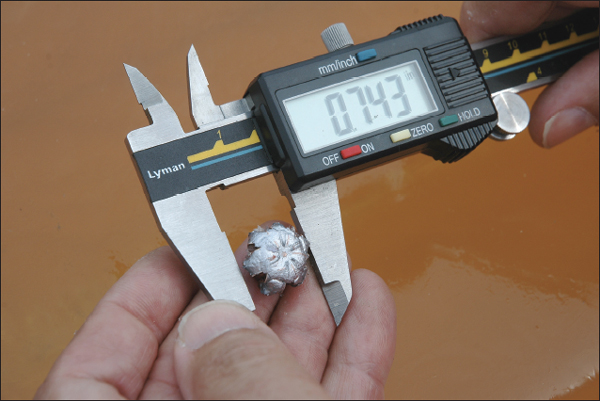
Bullet performance—upset, penetration, retained weight—is usually measured in ballistic gelatin.
Winchester Power Point. This softpoint might well be considered an archetype. It has no special features, save the nose notches on its tapered jacket. They ensure ready upset. Still, penetration is often to the far side of moose-size game. Power Point bullets were recently moly-coated and loaded to stepped-up velocities in Winchester Power Point Plus ammunition.
Winchester Ballistic Silvertip. Developed at Nosler, this Combined Technology product is a cosmetic variant of the Nosler Ballistic Tip. Its gray polymer nose and black jacket coating distinguish it. Fine accuracy, violent upset, and flat flight are hallmarks. Available in a variety of weights and diameters, it is popular in Supreme factory loads.
The effect of velocity on bullet performance can hardly be overstated. If you choose a stout bullet and commonly shoot a deer with your .30-06 beyond 200 yards, terminal velocity (say 2,000 fps) may not give you the upset you want. I once asked a Nosler executive why there was a Partition-style 170-grain .30-30 bullet. He agreed with me that at .30-30 speeds a Partition didn’t make sense, but added that retailers carrying the Nosler line wanted to stock bullets for hunters using .30-30s, and he wanted those bullets to be Noslers.
Actually, the drift toward stouter bullets is paradoxical. As hunters buy more powerful scopes and cartridges designed to give bullets flatter flight, they seem to be banking on long shots. The odds of having to shoot far and break both shoulders or thread an animal lengthwise are slim, as there is usually time to wait for a better angle. Also, by the time any high-velocity bullet has reached a distant target, it is moving considerably slower than when it started (figure about 25 percent loss in speed for a pointed bullet at 300 yards). Reduced impact velocity means less violent upset, less fragmentation.
Loads that shoot accurately and function faultlessly in your rifle inspire confidence and lead to more accurate shot placement afield. Confidence is a bigger asset than a bullet designed to thread six railroad ties, a stack of New York phone books and a 1950 John Deere engine block without losing more than 3 percent of its weight. What a bullet looks like when you dig it from a dead animal is not necessarily an indication of its lethality. After all, a set of worn tires may not look like much either. Before you settle on a bullet, buy several kinds, splitting boxes with friends to trim cost. You don’t need 50 shots to tell you a given bullet is inaccurate or acts like a grenade in wet newspaper. Keep your mind open to different bullet weights. When thin-jacketed softpoints were the only option, heavy bullets made sense for tough game, because all bullets lost significant weight during expansion and hunters needed a substantial remnant to penetrate. But these days, bullets needn’t be heavy to drive deep. Hiking bullet weight, you must reduce speed, trimming kinetic energy and making the bullet’s arc steeper at distance.
Whether you handload or shoot factory rounds, there are more than enough bullet choices to keep you busy testing during the off season. More shooting means that whatever bullet you choose is more apt to land in the right place and kill right away.
Table of contents
- Title Page
- Dedication
- Copyright
- Acknowledgments
- Foreword
- CONTENTS
- INTRODUCTION
- SECTION I: BALLISTICS IN HISTORY
- SECTION II: THE MUSCLE BEHIND THE SHOT
- SECTION III: BULLETS—THE INSIDE STORY
- SECTION IV: SPEED, ENERGY, AND ARC
- SECTION V : PUTTING BALLISTICS TO WORK
- SECTION VI: FOR LONGER REACH
- BALLISTICS TABLES FOR MODERN SPORTING RIFLES
- GLOSSARY